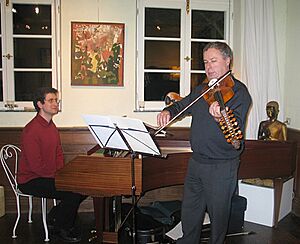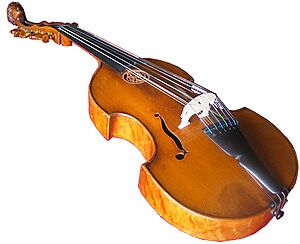Viola d'amore facts for kids
The viola d'amore is a special string instrument that was very popular in the 1600s and 1700s. It's a type of viola. Its name comes from Italian and means "viola of love." This instrument usually has 6 or 7 strings. You hold it under your chin and play it with a bow, just like a violin. Sometimes, musicians still use it today to play old music from the 1600s and 1700s. A few modern composers have also written new music for it.
Contents
How the Viola d'Amore Looks and Sounds
The viola d'amore is about the same size as a modern viola. However, its shape is more like an older instrument called a viol. Like viols, it has a flat back and wide sides. It also has sloped shoulders and a carved head at the top where the tuning pegs are.
Unlike a viol or a guitar, it doesn't have any frets. Frets are markings on the fingerboard that help you find the right notes. The sound-holes on the viola d'amore often look like a flaming sword.
This instrument usually has six or seven strings that you play with a bow. But it also has the same number of extra strings underneath! These are called sympathetic strings. They vibrate on their own when you play the main strings. This makes the sound richer, sweeter, and fuller.
When the Viola d'Amore Was Used

The viola d'amore became very popular during the 1600s. However, it slowly became less common. This happened because instruments from the violin family became more popular than those from the viol family. The viola d'amore was too quiet and sweet to play with the louder, modern violin family instruments.
But in the 20th century, some composers started writing for it again. For example, Paul Hindemith wrote music for the viola d'amore. Today, you can often hear the viola d'amore in groups that play Baroque music. These groups use old instruments from the Baroque period. You can hear it, for instance, in Bach’s famous St John Passion.
Images for kids
See also
 In Spanish: Viola de amor para niños
In Spanish: Viola de amor para niños






